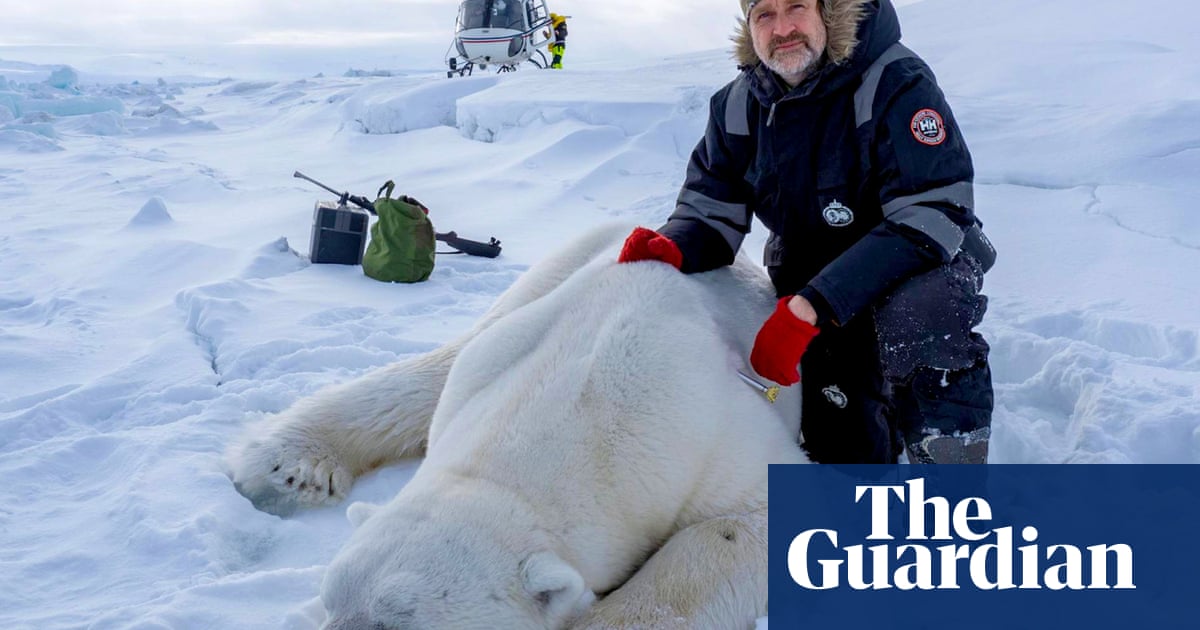When Rolf-Arne Ølberg is hanging out of a helicopter with a gun, he needs to be able to assess from a distance of about 10 metres the sex and approximate weight of the moving animal he is aiming at, as well as how fat or muscular it is and whether it is in any distress. Only then can he dart it with the correct amount of sedative. Luckily, he says, polar bears are “quite good anaesthetic patients”.
Ølberg is a vet working with the Norwegian Polar Institute, the body responsible for the monitoring of polar bears in Svalbard, an archipelago that lies between mainland Norway and the north pole. Every year he and his colleagues track the bears by helicopter, collect blood, fat and hair samples from them and fit electronic tracking collars.
Once he has darted them, the helicopter crew must move away from the bear to avoid more distress. “We see when they start to walk a little bit unsteadily, swaying from one side to the other, that the drugs are having an effect and then the bear will lay down,” says Ølberg. “This means that the dart has landed in a good place. If you just hit the fat, then you probably won’t have any effect at all. That animal will be quite awake.”
The aim of the annual monitoring programme is not just to understand more about the general biology of the bears but also to assess the impact of any threats to their population. In the 1960s, when the programme began, the greatest threat was hunting.
The number of bears was falling dramatically until, in 1973, they were given protection when Canada, Denmark, Norway, the US and the Soviet Union signed the agreement on the conservation of polar bears. The hunting stopped and the bear population grew – and is still thriving today. Now, the biggest threat is climate breakdown and the impact it will have in the years ahead.
“We have seen really significant changes to the sea ice,” says Jon Aars, senior scientist at the Norwegian Polar Institute, who has been following the bears for more than 20 years. “People started to see these changes in the 1990s, and of course you can still have good and bad ice years, but what has really changed is that now you have many, many more bad ice years.”
Aars keeps up with the fortunes of his bears “by text message”. Their collars send him information at regular intervals on things such as body temperature, whether they have been swimming and where they have travelled.
The samples the team take from the anesthetised bears can also tell him what the bears are eating, for example. “We see that they eat more land-based food than they used to,” he says. “Things like reindeer and birds.”
That is because the retreating sea ice has made a difference to where the bears go to find food. About 300 of the Barents Sea polar bear population stays in Svalbard year round and hunt on ice close to the islands. “When ice melts, they are forced on land,” says Aars. “These bears are now on land much more than they were 20 to 30 years ago.”
The rest of the bear population follows the sea ice when it retreats in the summer north east to Franz Josef Land, a Russian archipelago in the Barents Sea, to hunt. Rather than then return south to Svalbard to make dens in the winter, as they once would, scientists believe the retreating sea ice around the Norwegian archipelago means the bears are more often staying to create maternity dens in the Russian Arctic.
“The challenge will be if, in several years’ time, the conditions in Franz Josef are like those now in Svalbard,” says Aars. “We do see in several other polar bear populations that we are already at a stage where the warmer climate and loss of sea ice have had quite a significant impact on individuals and populations. We’re not there yet, but we know that these bears are depending on that ice.”
Meanwhile, Aars will continue to do his best for a species he knows down to the individual bear in some cases. “There are some female bears that I have captured 10 times and I know their names, which areas they move in and when they are due to give birth. It’s a privilege to do the work I do [getting close to the sedated bears], but for me it is much more exciting to be out there and to be able to see a bear free, to watch it passing by.”
Article by:Source: Lisa Bachelor

















